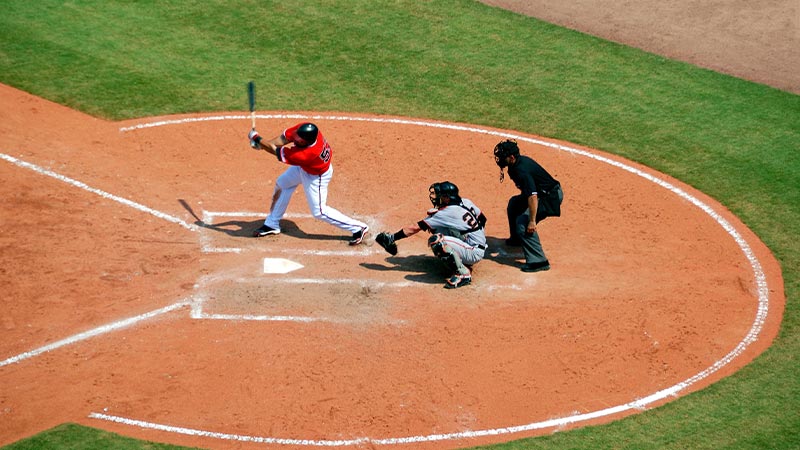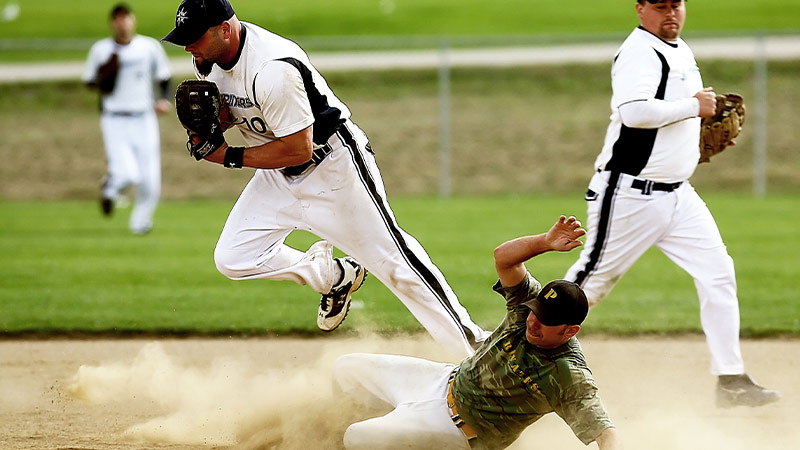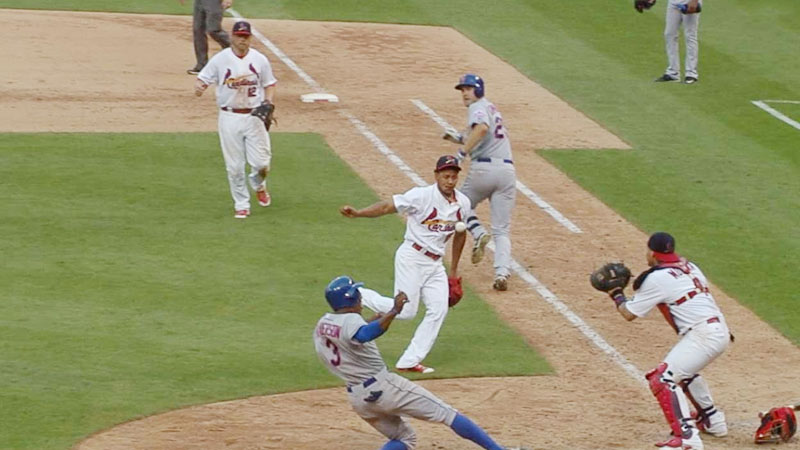Baseball is a sport rich in strategies and tactics, and one such intriguing play is the squeeze play. There is no doubt, it is a very exciting term used in baseball.
In this article, we will explore the concept of a squeeze play in baseball, including its variations, purposes, when teams call for it, and how to defend against it.
By delving into the intricacies of this play, we aim to provide a comprehensive understanding of the squeeze play and its significance in the game.
What Is A Squeeze Play In Baseball?
A squeeze play is a strategic maneuver used by the offensive team to score a run while the defensive team attempts to prevent it. It involves a combination of precise timing, coordination, and execution.
The primary objective of a squeeze play is to score a runner on the third base by making a well-placed bunt, usually while the pitcher delivers the ball to the plate.
The play can catch the defense off guard, leading to a swift and decisive scoring opportunity for the offensive team.
Safety Squeeze Play
The safety squeeze play is a slightly modified version of the squeeze play. It is often utilized when the offensive team wants to ensure a higher probability of success by minimizing the risk of a foul bunt.
The safety squeeze play involves instructing the runner on third base to wait until the bunt has been successfully laid down before breaking for home, reducing the chances of a failed attempt.
Suicide Squeeze Play
Contrary to the safety squeeze play, the suicide squeeze play is a high-risk, high-reward tactic. Here, the runner on third base breaks for home as soon as the pitcher begins the throwing motion, regardless of whether the bunt is successfully executed or not.
The success of the suicide squeeze play relies heavily on the bunter’s ability to lay down a well-placed bunt under pressure.
What Does It Mean to be Squeezed?
Being “squeezed” in baseball refers to the pressure exerted on the pitcher due to the strategic positioning of the offensive team.
The squeeze play puts the pitcher in a dilemma, as they must deliver a pitch while simultaneously being aware of the possibility of a bunt and a potential run scoring.
This can lead to mental and mechanical challenges for the pitcher, increasing the chances of a mistake that the offensive team can capitalize on.
General Purposes of a Squeeze Play

Here are the common purposes of a Squeeze play in baseball:
Break a tie game or gain the lead
One of the primary purposes of a squeeze play is to break a tie game or gain the lead. In tight, low-scoring contests, scoring opportunities may be limited.
A well-executed squeeze play can provide the offensive team with a critical run that can make all the difference in securing a victory.
Surprise the defense
Squeeze plays are often used as a surprise tactic to catch the defense off guard. By timing the play perfectly and executing it with precision, the offensive team can create confusion and disrupt the defensive team’s strategy.
The element of surprise increases the likelihood of success as the defense scrambles to react and make quick decisions.
Manufacture runs
Squeeze plays are part of a broader strategy to manufacture runs when traditional methods of scoring, such as hits or home runs, may be challenging to achieve.
By relying on small ball tactics, such as bunting and baserunning, teams can generate offense and put pressure on the defense to make plays.
Generate momentum
Successfully executing a squeeze play can provide a significant momentum boost for the offensive team. It energizes the players and fans, demoralizes the defense, and creates a sense of momentum and confidence.
This newfound momentum can carry over to subsequent innings and positively impact the team’s overall performance.
Force defensive errors
The pressure imposed by a squeeze play often forces the defense to make hurried or careless plays. Fielders may rush their throws or make errors due to the urgency of the situation.
The offensive team can capitalize on these defensive mistakes, potentially extending the play or even scoring additional runs beyond the initial squeeze attempt.
When Do Baseball Teams Call for a Squeeze Play?
Baseball teams call for a squeeze play in specific situations that favor its success:
- Runner on third base: The presence of a runner on third base, ideally with good speed and baserunning skills, is a prerequisite for a squeeze play.
- Fewer than two outs: The offensive team often attempts a squeeze play when there are fewer than two outs, as they have more flexibility to take risks while minimizing potential negative outcomes.
- Close game situations: Squeeze plays are more commonly employed in close game situations where a single run can significantly impact the outcome.
- Weaker batters at the plate: When a weaker batter is up to bat, a squeeze play can be employed as a strategic alternative to relying solely on the batter’s ability to make solid contact.
How to Defend Against the Squeeze?

Defending against a squeeze play requires a combination of anticipation, coordination, and execution by the defensive team. Here is an elaboration of the steps involved in defending against the squeeze:
Communication
Effective communication is essential for the defensive team to coordinate their actions and responsibilities. The pitcher, catcher, and infielders should communicate signals and strategies to ensure everyone is on the same page.
Defensive alignment
The defensive team must position themselves strategically to counter the squeeze play. The infielders should be prepared to charge toward home plate, while the outfielders should be ready to back up any potential plays at the plate or cover other bases.
Quick reaction
When a squeeze play is anticipated, the pitcher and catcher must react quickly and make the appropriate decisions.
The pitcher should focus on delivering a pitch that makes it difficult for the batter to bunt successfully, while the catcher should be ready to move swiftly and make the correct play based on the bunt attempt and the runner’s movement.
Execution of the play
The defensive team should aim to execute the defensive play flawlessly. This involves covering the bunt effectively, ensuring proper communication between fielders, and making accurate throws.
It is crucial for fielders to be aware of the situation, know where each runner is, and make decisive plays to prevent the runner from scoring.
Analyzing tendencies
To improve their chances of successfully defending against a squeeze play, the defensive team should study the offensive team’s tendencies and scouting reports.
By understanding the opponent’s strategies and tendencies in specific situations, the defense can anticipate squeeze play scenarios and adjust their defensive alignments and tactics accordingly.
This includes being aware of the base runners’ speed and the likelihood of a squeeze play being called based on the batter’s skill set.
By effectively anticipating, coordinating, and executing their defensive strategies, teams can minimize the success rate of squeeze plays and neutralize the offensive team’s scoring opportunities.
It requires a combination of skill, communication, and awareness to defend against the squeeze play effectively.
FAQs
Can a squeeze play be attempted with two strikes on the batter?
Yes, a squeeze play can be attempted with two strikes on the batter, but it significantly increases the difficulty and risk of executing a successful play.
With two strikes, the batter’s primary objective shifts from executing a successful bunt to protecting the plate and avoiding a strikeout. The defensive team is also more likely to anticipate a squeeze play in this situation, making it harder to catch them off, guard.
However, there have been instances where teams have successfully executed a squeeze play with two strikes, relying on the element of surprise and the batter’s ability to make contact under pressure.
Is a squeeze play legal in all baseball leagues?
Yes, the squeeze play is a legal and widely accepted strategy in all levels of baseball, from youth leagues to professional competitions. It is recognized as a legitimate tactic that teams can employ to gain an advantage on the field.
The rules of baseball do not specifically prohibit the use of a squeeze play, as long as it adheres to the general rules and regulations of the game.
However, leagues or tournaments may have their own specific rules regarding the use of certain strategies, so it is essential to be aware of any league-specific guidelines.
What happens if the batter misses the bunt during a squeeze play?
If the batter fails to make contact with the ball during a squeeze play, the runner on third base is typically tagged out, resulting in an unsuccessful play. The defensive team will be actively trying to cover the bunt and prevent the runner from scoring.
If the batter swings and misses or fails to get the bat on the ball, the catcher or infielders will quickly retrieve the ball and attempt to tag out the advancing runner before they reach home plate.
However, there are instances where the defense may misplay the bunt or fail to tag the runner in time, resulting in a scoring opportunity for the offensive team.
Can a squeeze play be attempted with a runner on second base?
While the primary scenario for a squeeze play involves a runner on third base, it is technically possible to attempt a squeeze play with a runner on second base, although it is much rarer.
In this situation, the offensive team would need to coordinate the timing between the runner on second and the batter executing the bunt.
The risk of attempting a squeeze play with a runner on second base is that the defense has a shorter distance to cover, making it easier to tag out the advancing runner. Additionally, the defensive team is more likely to expect a squeeze play with a runner on second, reducing the element of surprise.
How often do squeeze plays succeed in professional baseball?
The success rate of squeeze plays in professional baseball can vary depending on numerous factors, but on average, successful attempts occur around 50-70% of the time.
The success rate is influenced by factors such as the skill and execution of the bunter, the speed and baserunning ability of the runner on third base, the defensive positioning and awareness of the fielders, and the element of surprise.
Teams often reserve squeeze plays for critical moments in games, where the potential reward outweighs the risk. However, the success rate can fluctuate from season to season and varies between teams and situations.
Bottom Line
The squeeze play in baseball is a captivating and strategic maneuver that aims to score a runner on third base while putting immense pressure on the defense.
By understanding the intricacies of safety and suicide squeeze plays, the general purposes of employing a squeeze play, when teams call for it, and how to defend against it, both fans and players can gain a deeper appreciation for this exciting aspect of the game.
Whether executed flawlessly or defended successfully, the squeeze play adds an element of suspense and strategic thinking to the already thrilling sport of baseball. Thank you for your time.







